
Dublin to Reykavik
STYLE: LUXURY
The home of the brave requires no foreword. A windswept land of moors and castles, bloody history and rugged beauty, the Scottish Isles will enchant even the most jaded traveller. Legends keep the history alive here, fitting as the next stop on your itinerary, Iceland, is where storytelling takes on a new meaning. Vivid, robust and above all believable, welcome on a journey where folklore is king.
ITINERARY SUMMARY

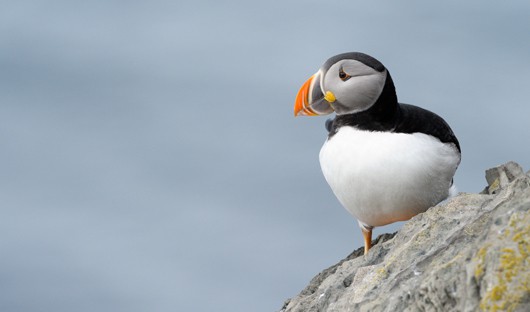
DAY 1 DUBLIN, IRELAND
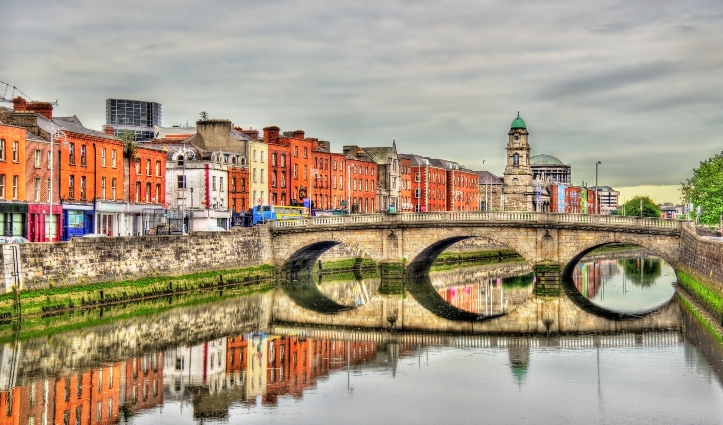
Dublin does boasts a beautiful setting: it loops around the edge of Dublin Bay and is on a plain at the edge of the gorgeous, green Dublin and Wicklow mountains, which rise softly just to the south. From the glass-wall top of the Guinness Storehouse in the heart of town, the sight of the city, the bay, and the mountains will take your breath away. From the city’s noted vantage points, such as the South Wall, which stretches far out into Dublin Bay, you can nearly get a full measure of the city. From north to south, Dublin stretches 16 km; in total, it covers 28,000 acres—but Dublin’s heart is far more compact than these numbers indicate. Like Paris, London, and Florence, a river runs right through it. The River Liffey divides the capital into the Northside and the Southside, as everyone calls the two principal center-city areas, and virtually all the major sights are well within less than an hour’s walk of one another. It is here where you will embark on the Silver Cloud in the afternoon.
DAY 2 IONA & LUNGA, UNITED KINGDOM

With a population of 120 residents, Iona is Located off the Southwest of Mull. The island is 4.8 kilometres long and 2.4 kilometres wide but draws in thousands of visitors each year due to its natural beauty and historical interest. Saint Columba and his fellow monks landed here in 563. This beautiful stretch of coastline brings out the true beauty of Iona facing onto the Gulf Stream that gives the island its mild climate. Located to the south of the road lies Sìthean Mòr (Large fairy hill) and alternatively known as the Hill of Angels, this is said to have been the setting for many rituals and traditions dating far back in history. This wonderful highlight, Iona Abbey was founded by Saint Columba in 563 and is said to have survived many Viking attacks. Although little remains of the monastic buildings of this period, the magnificent Abbey is the main attraction.
The stunning Isle of Lunga is the largest island in the Treshnish archipelago. With volcanic origin the isle was populated until the 19th Century, and remains of black houses can be seen around this magnificent coastal jewel. Abundant plant life and exotic birdlife are now the main inhabitants of the area. Fortunate visitors view the magnificent array of birds, especially the great puffins that breed on the islands plateau. One can sit within just a few metres away without disturbing the avian ambassador’s peace. The 81 hectare island is home to many rare and endangered plants such as, primroses and orchids. Views over the landscape and across the ocean can be seen from the 300 foot high cliffs.
DAY 3 OBAN & MALLAIG, UNITED KINGDOM
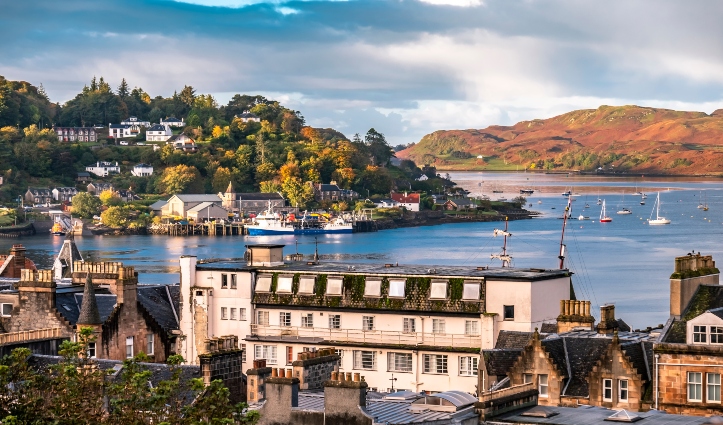
Oban, “little bay” in Gaelic, today has a resident population of 8,500 and is the unofficial capital of the West Highlands – the “Gateway to the Isles.” The panoramic views of the mountains, lochs and islands which have captivated artists, authors, composers, and poets for centuries are as striking now as they were when Dunollie Castle, a ruined keep which has stood sentinel over the narrow entrance to the sheltered bay for around six hundred years, was the northern outpost of the Dalriadic Scots. It is no surprise to find Oban in the 21st-century remains a magnet for travellers from all over the world.
The thriving port of Mallaig is situated on the North West coast of Scotland. A vibrant fishing port, its remote location makes it a perfect getaway to this quiet area. Walks around the town present magnificent views over the picturesque harbour and across Loch Nevis to Knoydart. The well-known Jacobite steam train that was featured in the Harry Potter movies follows the wonderful road to the isles that ends at Mallaig. Mallaig art Gallery offers a wide range of works by local artists; A fish merchant has set up a shop in the harbour offering freshly caught fish; local bars and cafes please all tastes; this vibrant town and port offers a broad portfolio of sights sounds and smells that will leave you with lasting memories.
DAY 4 PORTREE (ISLE OF SKYE), UNITED KINGDOM
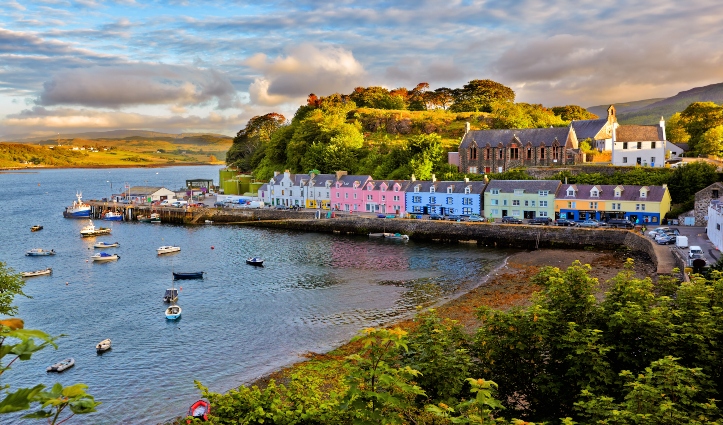
The Isle of Skye ranks near the top of most visitors’ priority lists: the romance of Prince Charles Edward Stuart, known as Bonnie Prince Charlie, combined with the misty Cuillin Hills and their proximity to the mainland all contribute to its popularity. Today Skye remains mysterious and mountainous, an island of sunsets that linger brilliantly until late at night and of beautiful, soft mists. Much photographed are the really old crofts, one or two of which are still inhabited, with their thick stone walls and thatch roofs. Orientation on Skye is easy: follow the only roads around the loops on the northern part of the island and enjoy the road running the length of the Sleat Peninsula in southern Skye, taking the loop roads that exit to the north and south as you please. There are some stretches of single-lane road, but none pose a problem.
DAY 5 ST. KILDA, UNITED KINGDOM
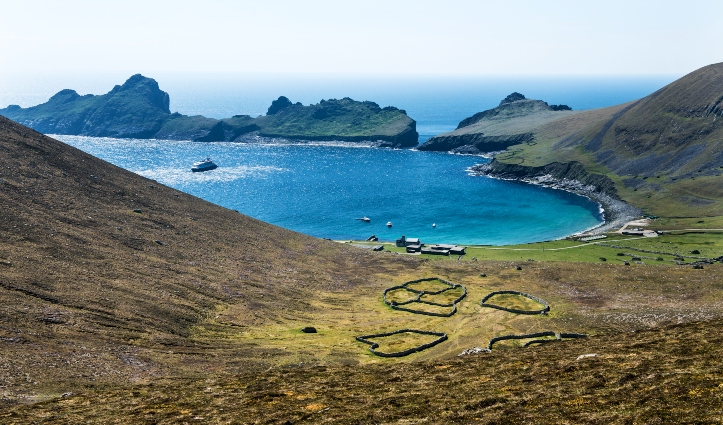
St Kilda is a remarkable uninhabited archipelago some 40 nautical miles beyond the Outer Hebrides. The stunning cliffs and sea stacks are home to the most important seabird breeding colony in northwest Europe. St Kilda is one of the few places in the world to have received dual World Heritage status from UNESCO in recognition of its Natural Heritage and cultural significance. Village Bay on the island of Hirta once supported a population of over 200, but the last islanders left in the 1930s. Recent restoration work on the village by the National Trust for Scotland offers a marvellous link with the past. One of the caretakers acts as shopkeeper and postmaster for any visitors who might like to send a postcard home from St. Kilda.
DAY 6 KIRKWALL (ORKNEY), UNITED KINGDOM
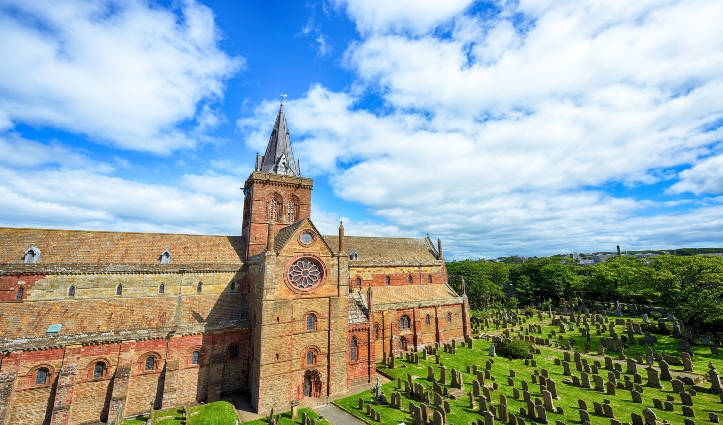
In bustling Kirkwall, the main town on Orkney, there’s plenty to see in the narrow, winding streets extending from the harbour. The cathedral and some museums are highlights.
DAY 7 LERWICK AND NOSS ISLAND, SHETLAND ISLANDS

Founded by Dutch fishermen in the 17th century, Lerwick today is a busy town and administrative center. Handsome stone buildings—known as lodberries—line the harbor; they provided loading bays for goods, some of them illegal. The town’s twisting flagstone lanes and harbor once heaved with activity, and Lerwick is still an active port today. This is also where most visitors to Shetland dock, spilling out of cruise ships, allowing passengers to walk around the town.
Exploring the sandstone cliff faces of the Isle of Noss will reveal ledges loaded with gannets, puffins, guillemots, shags, kittiwakes, Razorbills, fulmars and Great Skuas. The island was recognised as a National Nature Reserve in 1955, and has one of Europe’s largest and most diverse seabird colonies. Sheep have grazed the inland hillsides of Noss since the late 1800s and early 1900s when around twenty people lived on the island to manage the sheep farm. Along with the sheep, shaggy Shetland ponies graze the windblown slopes of Noss.
DAY 8 TORSHAVN, FAROE ISLANDS

Nearly 1,000 kilometres from Denmark’s west coast lie the Faroes, a triangle of eighteen windswept islands, seventeen of which are inhabited. Only 48,500 people plus some 70,000 sheep roam these remote lands. Much of the islands’ heritage reflects a medieval past, beginning with the arrival of farmers from western Norway who settled here in the 9th century. Evidence of this Scandinavian heritage is preserved through centuries of isolation; ancient structures can still be seen in villages clustered around old churches. Sheer cliffs and waterfalls carve Streymoy, the largest of the islands, where Torshavn is one of the world’s smallest capitals with about 12,400 inhabitants, plus another 5,000 living in the suburbs of Argir and Hoyvik. Visitors find interesting museums, churches, monuments and all the amenities of a modern town and thriving harbour here. The world’s oldest, still active parliament was founded in the Viking age.
DAY 9 VESTMANNA, FAROE ISLANDS

The Vestmanna bird cliffs are near vertical, volcanic cliffs that rise steeply out of the ocean to a height of over 600 meters. They are impressively covered with innumerable bird nesting sites as well rare and hardy vegetation. Literally tens of thousands of seabirds can be seen soaring along the cliffs, sitting on nests as well as swimming across the water. Species include numerous kittiwakes, Common Guillemots, Black Guillemots and the endearing Atlantic Puffin. In addition, several waterfalls cascade down in graceful mists from hundreds of metres in the air and explorations reveal a series of sea caves ranging from modest in size to enormous.
DAY 10 AT SEA

Days at sea are the perfect opportunity to relax, unwind and catch up with what you’ve been meaning to do. So whether that is going to the gym, visiting the spa, whale watching, catching up on your reading or simply topping up your tan, these blue sea days are the perfect balance to busy days spent exploring shore side.
DAY 11 AKUREYRI, ICELAND
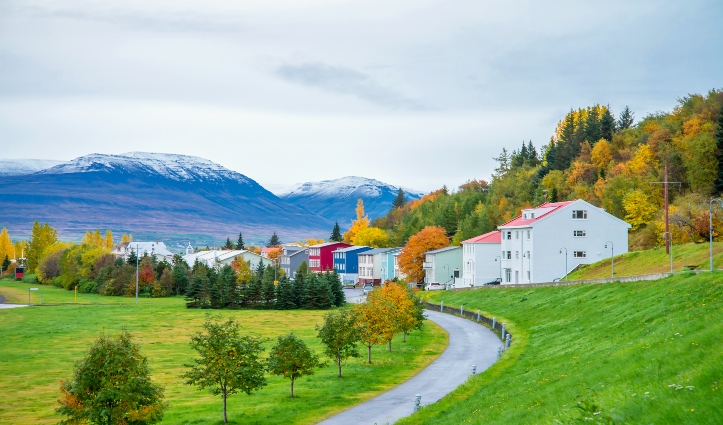
Iceland’s Capital of the North is the gateway to a thrilling land of roaring waterfalls, soaring volcanoes and glorious wildlife. It may lie a mere 100 kilometres from the Arctic Circle, but Akureyi blossoms with a bright, cosmopolitan feel, and explodes into life during the summer months, when its outdoor cafes and open-air bathing spots fill up with visitors ready to immerse themselves in Iceland’s cinematic scenery. Feel the thundering impact of Iceland’s celebrated natural wonders shaking your bones at Godafoss Waterfalls, known as the ‘Waterfalls of the Gods’. Here, the Skjálfandafljót river unleashes a colossal torrent of water over charcoal-black rocks below. Or, find some peace at the Botanical Gardens, which opened in 1957 and offer space for contemplation – amid plants that bloom with unexpected vibrancy, even at this northerly latitude.
The Lutheran, Akureyrarkirkja Church rises like a grand church organ and is the town’s most striking landmark. The 112-step climb is worth the effort to see light flooding in through its narrow stain glass windows, spreading colourful patchworks across the interior. Magic and mythology are important elements of Icelandic folklore, and you’ll even bump into giant sculptures of grizzled, child-snatching trolls on the town’s high street. Or, meet more earthly – but no less magical – creatures in the waters around Akureyi, where immense blue whales cruise by and dolphins playfully leap. A trip to the northerly Grimsey island will take you on an inspiring adventure traversing the Arctic Circle to a remote island where flame-beaked puffins nod on cliff-side perches and razorbills nest.
DAY 12 VIGUR ISLAND, ICELAND

Vigur Island is a little more than 1.6 km in length and about 412 m wide. This green oasis punctuates the waters of the Ísafjarðardjúp fjord east of the town of Isafjordur. The island is home to a single farming family and has some meticulously preserved historical landmarks including Iceland’s only windmill, built in 1840 and used until 1917 for grinding imported wheat from Denmark; and a 200-year-old rowing boat, which is still in use to ferry sheep to the mainland. Summer is the best time to see large numbers of Atlantic Puffins, Arctic Terns and Black Guillemots. One of the export articles from this small island was eider down and one can see where the eider ducks nest and how the down is collected and cleaned.
DAY 13 REYKJAVIK, ICELAND
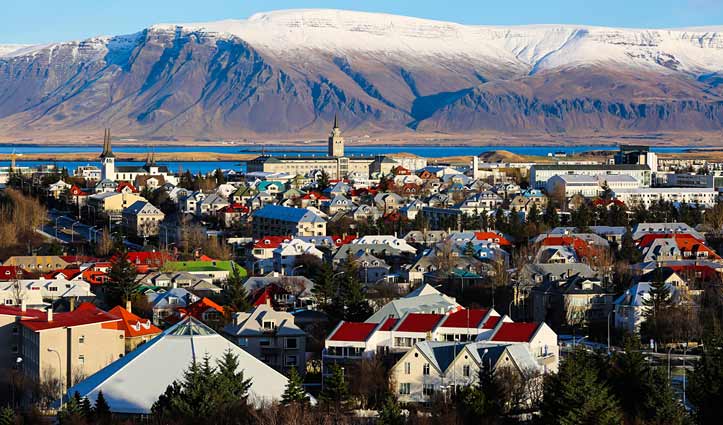
Sprawling Reykjavík, the nation’s nerve center and government seat, is home to half the island’s population. On a bay overlooked by proud Mt. Esja (pronounced eh-shyuh), with its ever-changing hues, Reykjavík presents a colorful sight, its concrete houses painted in light colours and topped by vibrant red, blue, and green roofs. In contrast to the almost treeless countryside, Reykjavík has many tall, native birches, rowans, and willows, as well as imported aspen, pines, and spruces. Reykjavík’s name comes from the Icelandic words for smoke, reykur, and bay, vík. In AD 874, Norseman Ingólfur Arnarson saw Iceland rising out of the misty sea and came ashore at a bay eerily shrouded with plumes of steam from nearby hot springs. Today most of the houses in Reykjavík are heated by near-boiling water from the hot springs. Natural heating avoids air pollution; there’s no smoke around.


